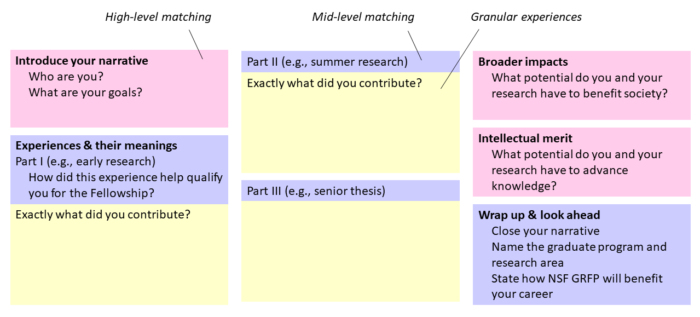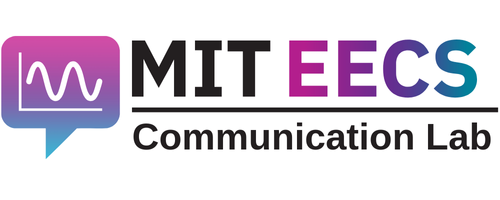Criteria for Success
- You are eligible for the Fellowship. (Be certain to check for restrictions, i.e., only U.S. citizens, nationals, and permanent residents are eligible.)
- Your personal statement convinces a panel of academics that you are qualified to receive the Fellowship, especially with respect to the Intellectual Merit and Broader Impact criteria.
- You show only those skills and experiences that demonstrate how you fit those criteria.
- The skills and experiences that you show are concrete and quantitative.
- Your personal statement meets the formatting and page limit criteria.
- Text is grammatically correct and free of typos.
Structure Diagram

Note that Broader Impacts and Intellectual Merit should be woven through all of your experiences as well as highlighted in separate sections. Sizes of sections are approximate.
Applications prior to 2018 did not require “Intellectual Merit” and “Broader Impacts” to be addressed under separate headings. Be sure to follow the most up-to-date guidelines provided by NSF, especially if you are referencing older examples.
Purpose
Your personal statement (technically, the “Personal, Relevant Background and Future Goals Statement”) is part of the NSF GRFP application and, naturally, is intended to convince the selection committee to award you the Fellowship.
The GRFP website says, “NSF Fellows are anticipated to become knowledge experts who can contribute significantly to research, teaching, and innovations in science and engineering.” The purpose of your application is to demonstrate your potential to satisfy this requirement.
The personal statement is the only part of the application where you get to lay out the experiences you’ve had, the goals you intend to pursue, and how those experiences and goals qualify you for the Fellowship.
Analyze Your Audience
Your entire application will be reviewed online by “disciplinary and interdisciplinary scientists and engineers, and other professional graduate education experts.” These are academics, usually from your broad area of science (e.g., materials research) but not from your specific subfield (e.g., optoelectronics). They will judge your application using some combination of the NSF’s official criteria for the Fellowship and their own ideas about what makes good science or a good scientist.
The people on the committee read many, many applications. Make it easy for them to figure out that you are qualified for the award by referencing the Intellectual Merit and Broader Impact criteria that they use to judge your application. Make it easy for them to remember you by creating a narrative that “brands” you.
Skills
Include Intellectual Merit and Broader Impacts criteria
Like many awards or jobs, there are explicit criteria that show if you qualify for the Fellowship. Read the most up-to-date program solicitation to learn the criteria that the selection committee are using to judge your application. Write your personal statement in a way that makes it as clear as possible that you meet these criteria.
The 2023 NSF solicitation says (emphases added):
The program recognizes and supports outstanding graduate students who are pursuing full-time research-based master’s and doctoral degrees in science, technology, engineering, and mathematics (STEM) or in STEM education. The GRFP provides three years of support over a five-year fellowship period for the graduate education of individuals who have demonstrated their potential for significant research achievements in STEM or STEM education.
The NSF GRFP criteria emphasize “Intellectual Merit” and “Broader Impacts.” Read the solicitation so you know what “Intellectual Merit” and “Broader Impacts” mean to the NSF, and use your personal statement to show how you meet those criteria. Do not just make up your own ideas about what these terms mean.
In the 2023 solicitation, NSF defines these terms: “The Intellectual Merit criterion encompasses the potential to advance knowledge… The Broader Impacts criterion encompasses the potential to benefit society and contribute to the achievement of specific, desired societal outcomes.” The NSF also has specific lists of activities that constitute Broader Impacts.
Be sure to include Broader Impacts and Intellectual Merit throughout your statement as well as in separate, labeled sections. According to the 2023 solicitation, “Applications that do not have separate headings for Intellectual Merit and Broader Impacts will not be reviewed.”
Create a personal narrative
Unlike a grant that funds a specific project, the NSF GRFP invests in the professional and scientific growth of individuals. The program solicitation talks about developing a “globally-engaged workforce” and ensuring “the Nation’s leadership in advancing science and engineering research and innovation.”
Your personal statement is your opportunity to show the selection panel that your personal goals (e.g., collaborating with foreign scientists) align with the program’s goals (e.g., creating a globally-engaged workforce). Tell a narrative about yourself that is honest, that you’re excited about, and that shows this alignment. Use this narrative through your entire personal statement. It should help you avoid writing a personal statement that is just a resume in essay format.
Concretize and quantify your experiences
Your experiences are the “what” of your essay. Which experiences led you to develop your skill set and passions? Where have you demonstrated accomplishment, leadership, and collaboration? Research, teaching, and extracurriculars may all be relevant. State concrete achievements and outcomes like awards, discoveries, or publications.
Quantify your experience or impact to make it more concrete. How many people were on your team? How many protocols did you develop? How many people were in competition for an award? As a TA, how often did you meet with your students?
Describe your actions rather than changes in your mental or emotional state; your personal statement is not a diary entry.
| Vague experience | Concrete experience |
| During this project, my mind was opened to the possibility of using different programming languages together to create code that is faster to run and easier to understand and modify. | During this project, I collaborated with other group members to develop a user-friendly Python wrapper for a 10,000-line Fortran library. |
| I showed initiative in my second project in the lab. | Frustrated with the direction of my first project, I consulted with other faculty and proposed an entirely new project. |
| During my first year, I became a more curious and capable scientist. | I explored the literature and proposed two alternative procedures to make the experiment more efficient. |
| I won the physics department’s Laser Focus prize. | I won the physics department’s prize for top student among my cohort of 20 students. |
| I learned about the influence of polymer structure on device efficiency. | I quantified the electrical properties of three polymers used in optoelectronic devices. |
Explain the meaning of your experiences
The meaning of your experiences is the “why” or “so what” of your personal statement. It’s good to have quantitative and concrete experience; it’s even more important to attribute meaning to those experiences.
Every set of experiences should speak to one of the requirements that the NSF GRFP solicitation lays out:
- How has this experience prepared you to seek a graduate degree?
- How will it help you become a knowledge expert?
- How will it help you contribute significantly to research, teaching, or innovations in science and engineering?
- How will your graduate experience prepare you for a career that advances knowledge and benefits society?
The connection between your experiences and the NSF GRFP’s goals may feel obvious to you, but you should make these connections explicit for your audience: this will make it easy for them to put you in the “yes” pile.
In terms of writing style, use statements about the meaning of experience as transitions between experiences. Try to “wrap” meaning around your experiences. Putting the meaning at the beginning and end of a paragraph makes it easy for a reader to understand what they should be taking away from the details in the middle.
| Experience only (schematic) | Experience and Meaning |
|
|
Content adapted by the MIT Electrical Engineering and Computer Science Communication Lab from an article originally created by the MIT Biological Engineering Communication Lab.
